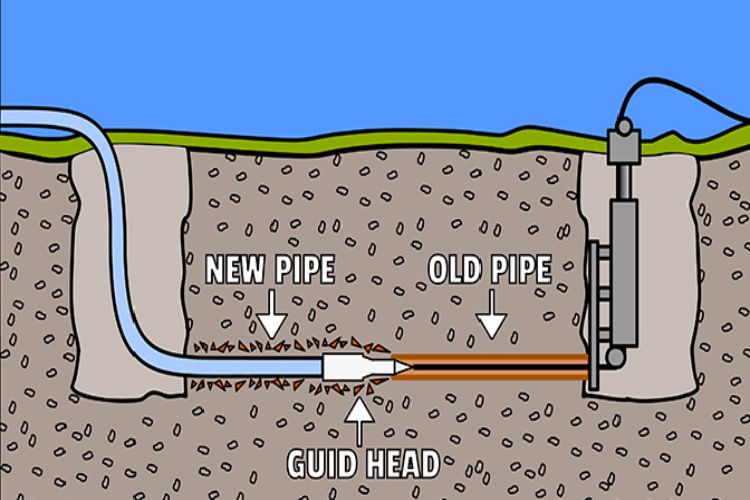 If you are experiencing a clogged or broken sewer line, it can cause major problems to your home and property. Traditional repair methods involve digging up large sections of your lawn and landscaping to locate & replace the damaged line.
If you are experiencing a clogged or broken sewer line, it can cause major problems to your home and property. Traditional repair methods involve digging up large sections of your lawn and landscaping to locate & replace the damaged line.
Trenchless repair is a much better alternative that reduces damage to your landscape and property. The two main types of trenchless sewer line repairs are pipe lining and bursting.
Pipe Lining
The most popular and versatile trenchless method for replacing sewer lines, pipe lining uses a durable liner that forms a new pipe inside your existing one. This creates a tube within a pipe, allowing new, more durable lines to be installed without disturbing your landscaping and home.
The pipe lining procedure causes minimal damage to your home than other types of excavation, and it’s also environmentally friendly. This is because the liner doesn’t require any added chemicals or other contaminants to install, and it can be finished in a much shorter amount of time than traditional methods take.
Two access points are opened at either end of the damaged pipe, and a long steel cable is pulled through the old pipe using a head similar to a jackhammer. This bursting head fractures the old pipe while simultaneously dragging and laying down a new high-density polyethylene (HDPE) pipe behind it.
This process is quick and can be done on most pipes, but it only works well for Orangeburg pipe (also known as tarpaper), very small pipes (2 inches or less in diameter), or pipes with many bends. It can also be less effective for sagging or bellying lines, which can only be fixed through excavation and installing a new sewer line. For these reasons, working with a trenchless company knowledgeable of all the different repair and replacement methods is important.
Pipe Bursting
The pipe-bursting process replaces damaged pipes without the need for traditional excavation. A specialized machine pushes a large head through the damaged line, crushing and breaking apart the old pipe and pulling a new one behind it. This method can be used to repair back-pitched, cracked, or separated pipes and increase the size of your sewer line if it’s too small for your needs.
This trenchless technique is much faster than traditional excavation and reduces the mess and property damage caused by the process. The landscaping and concrete are less likely to be damaged. And the whole work site can be cleaned in hours, not weeks.
The broken pieces of the original pipe are still in place and buried below the ground. It’s not necessarily negative, but some homeowners may find it upsetting. The benefits of this procedure outweigh any negatives.
The pipe-bursting method also uses HDPE pipe, which is environmentally safe to replace existing sewer pipes. This ensures that sewage is safely transported to the waste treatment plant and won’t seep into your home or business again. This also prevents the need for future excavation of your yard or other outdoor spaces.
Inspection
Trenchless sewer line repair is much faster than traditional methods and will cause minimal disruption to your property. You can still use your plumbing system during repairs, but you will not have to deal with loud construction work in front of your house for days. This method is also less expensive than traditional excavation.
The first step of the process is to run a camera inspection through your pipes. This will help your plumber identify any problems and decide if trenchless repair is viable. Once this is complete, the plumbing team will clean out your sewer line to ensure there are no blockages and that it is ready for repair.
Pipelining uses a thin liner to fill and cover the entire inside of your damaged pipe, sealing any cracks that might be causing sewage to leak out onto your property. The liners are initially flexible and soft, but they are possessing a resin that dries into a durable, watertight seal. The liners are then fed through your old pipe with a winch tool and expand to fill the space within the existing line.
The other trenchless method of sewer line replacement is called pipe bursting. A new HDPE (high-density polyethylene) replacement pipe is pulled into your damaged pipeline using the same winch tool. The bursting head will break apart the old line while simultaneously pulling in the new one to replace it.
Repair
The prospect of having to dig up and repair damaged water or sewer pipes is something most homeowners dread. Traditionally, it meant having construction crews digging for days, ruining pricey landscaping, and creating huge piles of dirt that would need to be replaced. Fortunately, today’s experienced plumbing contractors can often use trenchless methods to repair or replace sewer lines.
Trenchless sewer line repair offers a minimally invasive solution for fixing underground pipes without extensive digging. This innovative method reduces disruption to your property and can be more cost-effective. For more traditional excavation services, look at this web-site to explore professional sewer excavation options tailored to your needs.
Two common trenchless repair methods are pipe lining and pipe bursting. Pipe lining involves injecting a soft and flexible pipe liner imbued with resin to completely cover the inside of an existing broken pipe. This enables the repaired line to have the same durability and lifespan as the original pipe but with the added advantage of being less intrusive.
This method requires only one or two access points, usually a plumbing cleanout and rooftop vent stacks, to perform the entire repair. This cuts down on the damage to your landscaping and makes it easier to visually inspect the completed job to ensure everything went according to plan. However, pipe lining isn’t suitable for all situations. For example, if your sewer pipes are made of brittle clay or Orangeburg pipes or have significant root invasions, you’ll likely need to replace them rather than repair them. In these cases, there are other options than trenchless excavation. Choosing a reputable contractor with years of experience performing conventional and trenchless repairs is important.




